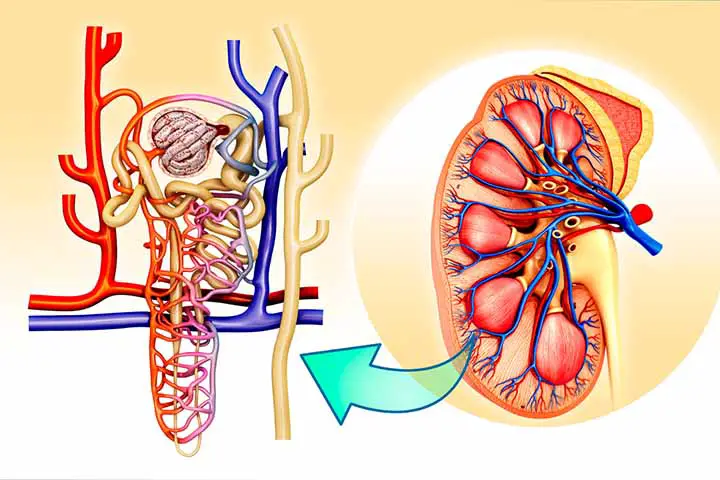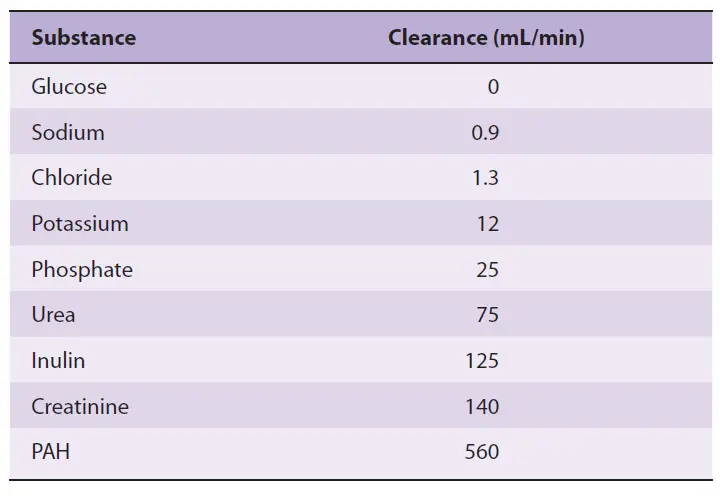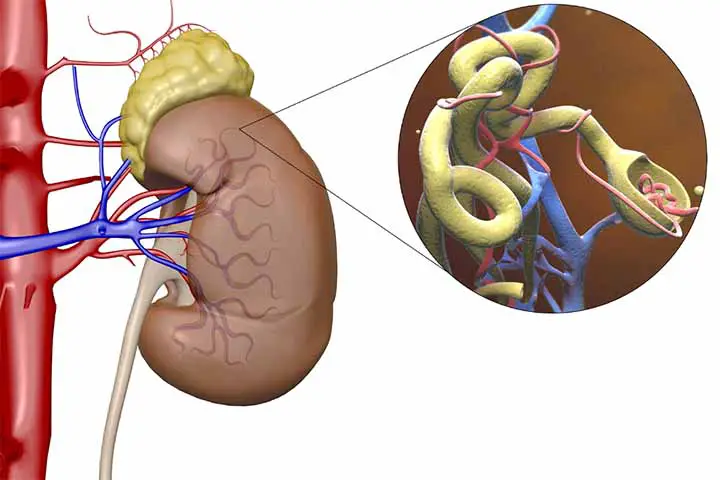Table of Contents
Renal Plasma Flow
As long as the volume in the red cells remains constant during passage through the kidney, renal plasma flow (RPF) equals the amount of a substance excreted per unit of time divided by the renal arteriovenous difference.
In a sleeping adult, the kidneys receive 1.2–1.3 L of blood per minute or slightly less than 25% of cardiac output. Renal blood flow can be measured using electromagnetic or other forms of flow meters, or it can be calculated by applying the Fick theory to the kidney; that is, calculating the volume of a given substance taken up per unit of time and dividing the value by the arteriovenous difference for the substance into the kidney.
Any excreted material should be used if its concentration in arterial and renal venous plasma can be determined and if it is not metabolized, processed, or formed by the kidney and does not itself impair blood flow.
Read Renal Infarction

Measurement(Calculation) of Renal Plasma Flow (RPF)
RPF can be determined by infusing p-amino-hippuric acid (PAH) and measuring its concentrations in the urine and plasma. PAH is purified and secreted by the glomeruli, resulting in a high extraction ratio (arterial concentration minus renal venous concentration divided by arterial concentration). When PAH is injected at low doses, for example, 90 percent of the PAH in arterial blood is lost in a single kidney circulation. As a result, calculating the “RPF” by dividing the volume of PAH in the urine by the plasma PAH level, while ignoring the level of renal venous blood, has become prevalent. Since the PAH concentration in peripheral venous plasma is almost equivalent to that in arterial plasma reaching the kidney, it may be used. To imply that the amount of renal venous plasma was not measured, the obtained value should be referred to as the effective renal plasma flow (ERPF). ERPF in humans is approximately 625 mL/min.

For Example:
UrinePAH (Concentration of PAH in urine) = 20 mg/mL
V (Urine Flow) = 0.8 mL/min
PlasmaPAH (Concentration of PAH in plasma) = 0.02mg/mL

It should be remembered that the ERPF calculated in this manner is the Clearance of PAH(CPAH). The definition of clearance is explored in-depth further below.
ERPF can be transformed to RPF (actual renal plasma flow) by the calculation following;
An average PAH extraction ratio is 0.9

Calculation of Renal Blood Flow (RBF) from Renal Plasma Flow (RPF)
RBF can be determined by dividing the renal plasma flow by 1 minus the hematocrit:
Hematocrit (Hct): 45%

Calculation of Glomerular Filtration Rate (GFR)
Glomerular filtration rate (GFR) is the amount of plasma ultrafiltrate produced per minute and can be determined in intact laboratory animals and humans by measuring a substance’s plasma level and the amount of that substance excreted. A material used to calculate GFR must pass freely through the glomeruli and not be secreted or reabsorbed by the tubules.
The Material appropriate for measuring GFR should be nontoxic and not metabolized by the body, in addition to being freely filtered and not reabsorbed or secreted in the tubules. Inulin, a 5200 molecular weight fructose polymer, meets these requirements in humans and most animals and can be used to calculate GFR.
The volume of plasma from which a substance is fully eliminated by the kidney in a given period of time (usually a minute) is referred to as renal plasma clearance.
The amount of that substance that occurs in the urine per unit of time is the product of renal filtering of a certain number of milliliters of plasma containing that amount. GFR and clearance are both measured in milliliters per minute (mL/min).
If the substance is denoted by the letter X, the GFR is equal to the concentration of X in urine (UX) multiplied by the urine flow per unit of time (V) divided by the arterial plasma level of X (PX), or V/PX. This is known as the clearance of X (CX).
In reality, an intravenous loading dose of inulin is given, followed by a sustaining infusion to maintain the arterial plasma level constant. After the inulin has been equilibrated with body fluids, a precisely timed urine specimen is collected, followed by a plasma sample halfway through the collection. The concentrations of inulin in the plasma and urine are determined, and the clearance of inulin (CInulin) calculated:
UInuline = 35mg/mL
V= 0.9 ml/min
PInulin = 0.25 mg/mL


Clearance of creatinine (CCr) can also be used to calculate GFR; however, since some creatinine is secreted by the tubules, creatinine clearance would be significantly higher than inulin clearance. Despite this, endogenous creatinine clearance is a fair estimation of GFR since the values agree very well with inulin-measured GFR values. However, PCr values are more commonly used as an indicator of renal function (normal1 mg/dL).

Read Pulmonary Vascular Resistance
Controlling Factors of GFR
The factors regulating glomerular capillary filtration are the same as those governing glomerular capillary filtration in general. Namely the size of the capillary bed, capillary permeability, and hydrostatic and osmotic pressure gradients throughout the capillary wall.
For each nephron, the equation can be:
GFR = Kf [(PGC – PT) – (πGC – πT)]
When Kf is a product of glomerular hydraulic wall conductivity (ie, its permeability) and the effective filtration surface area of the glomerular ultrafiltration coefficient. PGC is the mean hydrostatic pressure in glomerular capillaries, PT means hydrostatic pressure in the tubular (the space of Bowman), the plasma oncotic pressure in glomerular capillaries, and the oncotic pressure in the tubular filtrate (The space of Bowman).
Read Renal Parenchymal Disease.
Few Last Words About RPF
RPF can be calculated easily by measuring the clearance of p-amino-hippuric acid (PAH) or by Renal blood flow or GFR.
Read Renal Fascia
Last Updated on February 23, 2022 by Learn From Doctor Team






